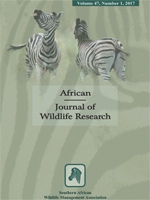Human-wildlife conflict and habitat loss are threatening carnivore populations in southern Africa, where the bulk of research focuses on large predators. However, scant research exists on medium and small carnivore (mesocarnivore) ecology. We employed hierarchical community modelling to estimate the effect of habitat on species occurrence and the effect of bait on detection probabilities for the carnivore community in the Mashatu Game Reserve, Botswana. We tested sites baited with either impala (Aepyceros melampus) meat (meat sites) or cheesecloth soaked in used cooking fat (fat rag sites) against unbaited sites (control sites). Within each bait classification, we divided our sampling effort between two habitat classifications, riverine and non-riverine sites. Thirteen of 16 carnivore species inhabiting the area (81%), including 10 of 12 species of mesocarnivore (83%), were recorded. Occupancy rates were higher in riverine habitat for several species, in particular African civet (Civettictis civetta), brown hyaena (Hyaena brunnea), and large-spotted genet (Genetta tigrina), demonstrating the importance of riverine habitat, which is declining in the study region. Our results suggest that the use of bait improves detectability. Several large carnivores, including spotted hyaena (Crocuta crocuta), brown hyaena, and leopard (Panthera pardus), were detected at highest rates at meat sites. Many mesocarnivores, including black-backed jackal (Canis mesomelas) and African civet responded equally to meat and fat rag sites, with detections greater than at control sites. Notably, large-spotted genet showed highest detection rates at fat rag sites, and brown hyaena showed higher rates at fat rag sites than control sites. Our detection results indicate that spent cooking fat may be used as an effective bait alternative to meat when studying mesocarnivore communities in southern Africa, whereas meat may still be the most effective for studying large carnivore communities. Identifying effective methods of increasing detection rates will benefit carnivore survey and monitoring initiatives, especially for cryptic species.
How to translate text using browser tools
1 April 2017
Estimating Occurrence and Detectability of a Carnivore Community in Eastern Botswana using Baited Camera Traps
Lauren C. Satterfield,
Jeffrey J. Thompson,
Andrei Snyman,
Luis Candelario,
Brian Rode,
John P. Carroll
ACCESS THE FULL ARTICLE





